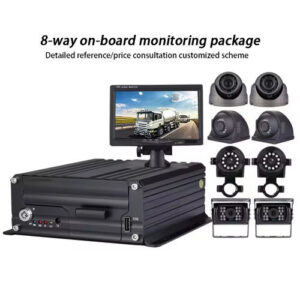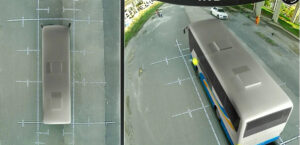For auto parts distributors, understanding the various power methods for backup wireless cameras is essential to meeting diverse customer needs. As vehicle safety technology advances, wireless backup cameras have become increasingly popular due to their simplified installation and versatility. This article explores the primary power methods available for these systems, with a focus on specific application scenarios to help distributors recommend the right solutions for different vehicles and use cases.
Traditional Power Methods: Hardwiring to Vehicle Electrical Systems
The most common and reliable power method for wireless backup cameras involves connecting to the vehicle’s existing electrical system. This approach offers consistent power but requires some installation expertise.
Reverse Light Integration
Many wireless backup camera systems are designed to draw power from the vehicle’s reverse light circuit. This method offers several advantages:
•Automatic activation: The camera powers on only when the vehicle is in reverse, conserving energy
•Simplified wiring: Installers need only tap into the reverse light wiring
•Universal compatibility: Works with virtually any vehicle with standard reverse lights
For auto parts distributors, reverse light-powered systems represent an excellent middle-ground option for customers seeking reliability without excessive installation complexity. These systems are particularly valuable for commercial fleet upgrades where consistent performance is prioritized over installation simplicity.
Fuse Box Connection
For always-on camera functionality, direct connection to the vehicle’s fuse box provides continuous power:
•Constant monitoring: Camera remains active regardless of gear selection
•Professional installation: Typically requires professional installation with fuse taps or direct wiring
•Versatile application: Ideal for delivery vehicles and commercial trucks requiring constant rear visibility
When recommending fuse box connections to customers, emphasize the need for proper circuit protection and professional installation. This solution is particularly valuable for commercial vehicles where continuous monitoring of cargo areas is necessary, such as delivery vans or refrigerated trucks.
Self-Contained Power Solutions: Battery and Solar Options
For scenarios where hardwiring is impractical or undesired, self-contained power solutions offer significant advantages in terms of installation simplicity and versatility.
Rechargeable Battery Systems
Battery-powered wireless cameras have evolved significantly, now offering extended operation periods between charges:
•Installation simplicity: No wiring required, making them ideal for quick deployment
•Portability: Can be easily transferred between vehicles
•Temporary usage: Perfect for rental fleets or seasonal equipment
Modern lithium battery systems typically provide 1-3 months of operation on a single charge, depending on usage patterns. For distributors, these represent an excellent option for customers seeking temporary solutions or those with limited technical installation capabilities.
Solar-Powered Systems
Solar-powered backup cameras represent the cutting edge of self-contained power solutions:
•Perpetual operation: Solar panels continuously recharge internal batteries during daylight hours
•Zero-maintenance: No need for manual recharging in most climate conditions
•Environmental appeal: Eco-friendly solution with no energy consumption from the vehicle
Industry data shows solar systems typically achieve 99.7% uptime in regions with moderate to high sun exposure. These systems are particularly valuable for agricultural equipment, construction vehicles, and other applications where vehicles are frequently stored outdoors.
Hybrid Power Systems
The latest innovation in backup camera power technology combines multiple power sources for maximum reliability:
•Solar primary with battery backup: Solar panels charge high-capacity batteries for 24/7 operation
•Hardwired with battery backup: Maintains functionality even when vehicle power is disconnected
•Dual-battery systems: Primary and secondary power sources for critical safety applications
For distributors, hybrid systems represent a premium offering for customers with mission-critical applications where camera downtime is unacceptable, such as emergency vehicles or high-value cargo transport.
Quick-Connect Solutions: Plug-and-Play Options
For maximum installation simplicity, several plug-and-play power options have emerged in the market.
Cigarette Lighter/12V Outlet Power
These systems plug directly into the vehicle’s 12V power outlet:
•Zero installation: Simply plug in and use
•Universal compatibility: Works with any vehicle featuring a standard 12V outlet
•Immediate deployment: No tools or technical knowledge required
The primary limitation is the need for a power cable running from the front of the vehicle to the display unit. This solution is ideal for rental car companies, vehicle sharing services, and customers seeking temporary safety enhancements.
OBD-II Port Power
Some innovative systems now draw power directly from the vehicle’s OBD-II diagnostic port:
•Clean installation: No dangling cables or adapters
•Automatic power management: Integrates with vehicle’s power management system
•Advanced features: Potential for integration with vehicle diagnostic data
These systems typically appeal to technology-focused customers and those seeking a clean, professional-looking installation without permanent modifications.
Application Scenarios: Matching Power Methods to Vehicle Types
Different vehicle categories have distinct requirements that influence the optimal power solution for backup camera systems.
Commercial Trucks and Fleets
For commercial applications, reliability and durability are paramount:
•Recommended solution: Hardwired systems with fuse box connection
•Key benefits: Consistent performance, weather resistance, tamper-proof installation
•ROI factors: Reduced accident liability, improved operational efficiency, decreased insurance premiums
Case study: A regional delivery company with 140 vehicles reported a 37% reduction in backing accidents and a 12% decrease in insurance premiums after implementing hardwired wireless camera systems across their fleet.
Recreational Vehicles and Trailers
RVs and trailers present unique challenges due to their size and intermittent usage patterns:
•Recommended solution: Solar-powered systems with battery backup
•Key benefits: Maintenance-free operation, continuous monitoring even during storage
•ROI factors: Simplified hitching process, reduced collision risk, enhanced resale value
For distributors serving the RV market, emphasizing the self-sustaining nature of solar systems can be particularly effective, as these vehicles often sit unused for extended periods.
Agricultural and Construction Equipment
Heavy equipment operates in harsh conditions requiring robust solutions:
•Recommended solution: Hybrid systems with multiple power redundancies
•Key benefits: Dust and vibration resistance, all-weather operation, extended service intervals
•ROI factors: Reduced workplace accidents, equipment damage prevention, operational continuity
The ability to withstand extreme temperatures (-40°F to 185°F) and maintain functionality despite heavy vibration makes hybrid systems particularly valuable in these demanding environments.
Aftermarket Consumer Applications
For individual vehicle owners seeking safety upgrades:
•Recommended solution: Reverse light integration or battery-powered options
•Key benefits: Balance of reliability and installation simplicity
•ROI factors: Enhanced vehicle value, improved safety, parking convenience
Consumer applications typically prioritize ease of installation and aesthetic considerations, making wireless systems with minimal visible wiring particularly appealing.
Installation Considerations for Distributors
When advising customers on backup camera power solutions, several key factors should influence recommendations:
•Technical capability: Assess the customer’s installation resources and expertise
•Usage patterns: Determine if the camera needs to function when the vehicle is off
•Environmental conditions: Consider exposure to temperature extremes, moisture, and direct sunlight
•Budget constraints: Balance initial costs against long-term reliability requirements
•Regulatory compliance: Ensure solutions meet relevant safety and electrical standards
Providing comprehensive installation guides and technical support resources can significantly enhance customer satisfaction and reduce return rates.
Conclusion: Powering the Future of Vehicle Safety
The diversity of power solutions for wireless backup cameras enables auto parts distributors to offer tailored recommendations for every application scenario. From simple plug-and-play systems to sophisticated hybrid power solutions, the technology continues to evolve to meet market demands for reliability, simplicity, and performance.
By understanding the specific advantages and limitations of each power method, distributors can position themselves as knowledgeable advisors rather than mere parts suppliers, creating value beyond the physical products themselves.
For a personalized demonstration of our complete range of backup camera power solutions and to discuss wholesale distribution opportunities, submit the form below to schedule a consultation with our product specialists.






